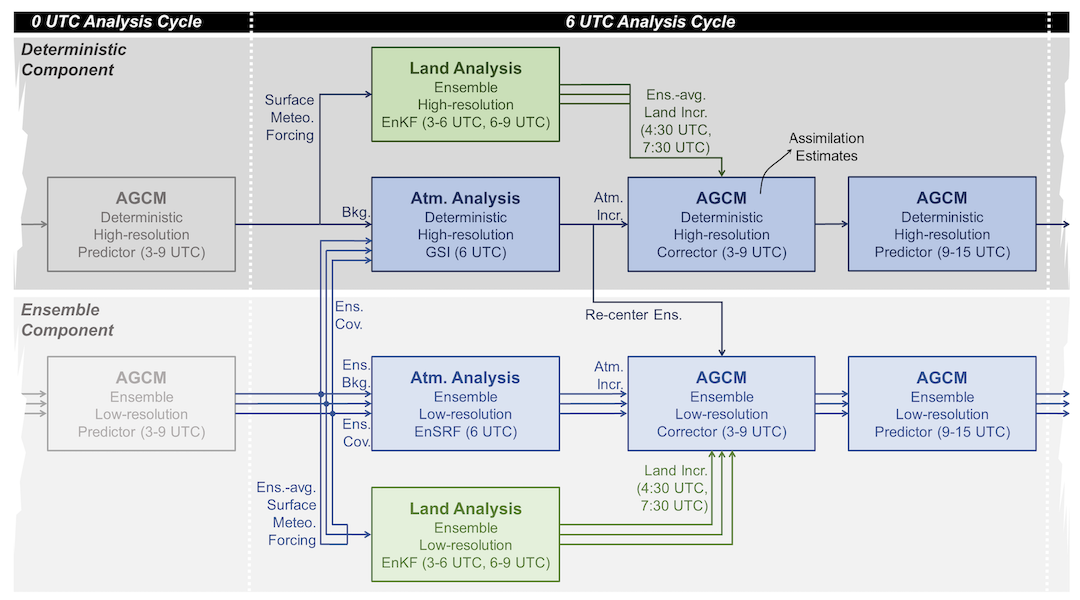Andrew Fox, Qing Liu, and Rolf Reichle Granted ROSES-23 Funding for CYGNSS; Fox to Serve as Project's PI
5.28.2024
GMAO members Andrew Fox, Qing Liu, and Rolf Reichle recently had their proposal accepted as part of NASA ROSES-23 A.26 CYGNSS Competed Science Team and will receive funding for their project, titled "Enhancing Coupled Land-Atmosphere Reanalysis Through the Assimilation of CYGNSS Soil Moisture Retrievals.” Andrew Fox will serve as PI for the project, which will aim to leverage GEOS LDAS and the weakly-coupled land-atmosphere data assimilation system to investigate the potential benefits of assimilating CYGNSS soil moisture observations in future reanalysis. The full proposal summary offers a full explanation of their upcoming work:
Atmospheric reanalyses play a crucial role in meteorology and climate science. They offer a comprehensive understanding of past weather patterns, contributing to our knowledge of climate variability and change, and critical benchmarks for model assessment. Additionally, land-only reanalyses offer comprehensive information on land surface variables such as soil moisture and snow cover, important for hydrology, agriculture, biogeochemistry, and ecology. Therefore, within the solicited research Sub-element 2.1 "Scientific Studies Leveraging the Full Time-Series of CYGNSS Observations" we propose to "develop methods to assimilate CYGNSS observations with the aim of their incorporation into long-term earth system reanalyses". Specifically, we will develop capabilities to assimilate the CYGNSS soil moisture (SM) product into the Goddard Earth Observing System (GEOS). We will test the impact this has on simulated SM, 2-meter temperature and humidity, and numerical weather prediction (NWP) skill in the coupled land-atmosphere model. By jointly assimilating Soil Moisture Active Passive (SMAP) brightness temperatures (Tb) and ASCAT soil wetness retrievals with the CYGNSS SM product we will be able to assess the additional skill resulting from the more frequent overpasses of the CYGNSS observations. These developments pave the way for the use of CYGNSS SM data in the next GEOS reanalysis.
NASA GMAO are working to incorporate land surface satellite observations into GEOS reanalysis products. This effort uses the GEOS land data assimilation system (GEOS LDAS), which applies the ensemble Kalman filter (EnKF) to the GEOS Catchment model. GEOS LDAS is used in operations to produce the SMAP Level-4 SM product. It has also been coupled with the GEOS atmospheric data assimilation system. This new, weakly-coupled land-atmosphere DA system has been demonstrated to improve NWP skill when SMAP Tb observations are assimilated. Building upon these capabilities we propose to incorporate the CYGNSS SM product and test its impact on land-only and atmospheric reanalysis as follows:
- 1. Develop a CYGNSS SM product specific reader for GEOS LDAS and determine quality control filtering.
- 2. Establish bias correction routines from climatological differences between model estimated and CYGNSS SM.
- 3. Conduct experiments to assess the impact of assimilating CYGNSS observations on SM estimates in a land-only analysis.
- 4. Conduct experiments to assess how the additional information from assimilation of CYGNSS SM and SMAP Tb and ASCAT soil wetness observations improves SM estimates in a land-only analysis.
- 5. Investigate the impact of adding the CYGNSS SM product to land observations assimilated in the weakly-coupled GEOS land-atmosphere DA system on NWP skill.
- 6. Prepare a workflow and data archive for CYGNSS observations in future GEOS reanalyses.
We believe this proposal is highly responsive as it will "enhance our understanding of the Earth System by leveraging the full temporal record of observations available from CYGNSS". We will develop a core NASA tool, GEOS LDAS, to enable it "to assimilate CYGNSS observations". We will use "CYGNSS soil moisture observations in conjunction with the SMAP mission", and by jointly assimilating the CYGNSS SM product and SMAP Tb we will be able to directly assess "how CYGNSS data will provide new or supplemental scientific information or knowledge to the other NASA data". With existing NASA GEOS capabilities, we will be able to "utilize CYGNSS products to better understand Earth System processes" to see how the assimilation of the CYGNSS SM product "can be used to improve the lower-tropospheric temperature and water vapor characterization", and thus potentially improve NWP skill. A key outcome will be the development of a clear pathway for the use of CYGNSS observations in upcoming GEOS reanalysis activities and "their incorporation into long-term earth system reanalyses."


